Warming up a stuffed animal can transform a simple plush toy into a source of comfort and warmth, especially on chilly nights or when seeking a cozy companion. The process is straightforward and can be accomplished through various methods that are safe for the toy and the person seeking comfort.
In this guide on how to warm up a stuffed animal, we will explore some practical and child-friendly ways to give your stuffed animal just the right amount of warmth, ensuring it’s snuggly and ready for cuddles or to provide gentle relief for aches and pains.
Whether you’re preparing a bedtime friend for a child or looking for a soothing warmth for yourself, this guide will walk you through the warming journey step by step.
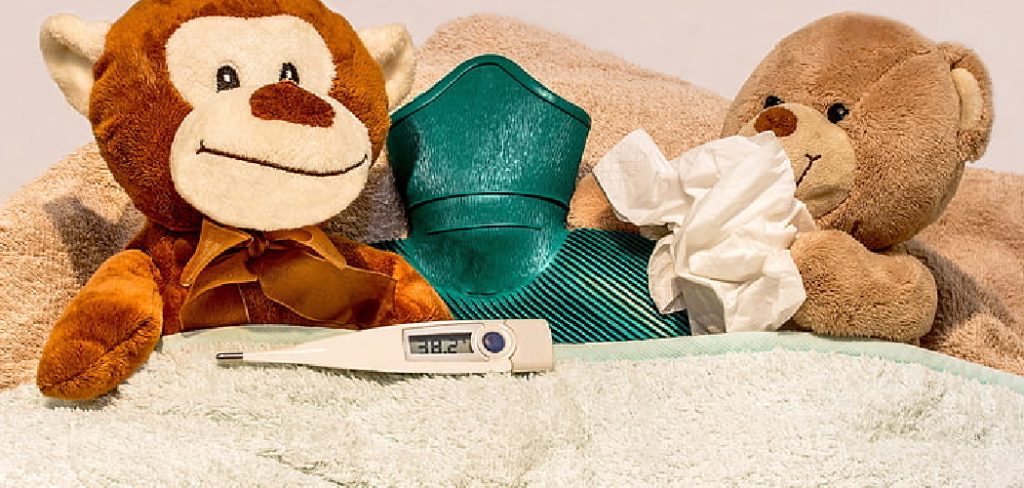
What is the Importance of Warming Up a Stuffed Animal?
Warming up a stuffed animal comes with several other benefits besides providing warmth and comfort.
Some stuffed animals have heatable packs inside them that release warmth when heated, which can be great for soothing sore muscles or tummy aches. Additionally, the warmth can promote relaxation and reduce stress levels, making it an ideal way to soothe an anxious child or adult.
Moreover, warming up a stuffed animal can also enhance the overall sensory experience of cuddling with a plush toy, making it feel more lifelike and huggable.
What Will You Need?
Before you begin warming up your stuffed animal, gathering all the necessary supplies is important. This will ensure a smooth and stress-free process. Here are some essential items you may need:
- Stuffed Animal: Of course, you’ll need the main star of this process – your stuffed animal! Choose a clean and dry one.
- Microwave-safe Container: If you’re using a microwave to warm up your stuffed animal, ensure you have a safe container in the microwave. This can include a microwave-safe plate, bowl, or bag.
- Heating Pad: A heating pad is another excellent option for warming up your stuffed animal. It’s instrumental if you want constant warmth for an extended period of time.
- Hot Water Bottle: Similar to a heating pad, a hot water bottle can provide consistent warmth for your stuffed animal. Just make sure the bottle is properly sealed and won’t leak.
- Heat Source: If you don’t have access to a microwave, heating pad, or hot water bottle, you can use other heat sources like a hairdryer, warm towels, or even a warm oven.
- Blanket: To keep your stuffed animal cozy and warm for longer, you can wrap it in a soft and cozy blanket after warming it up.
Now that you have all the necessary items let’s get started! Here are some simple steps to follow when warming up your stuffed animal.
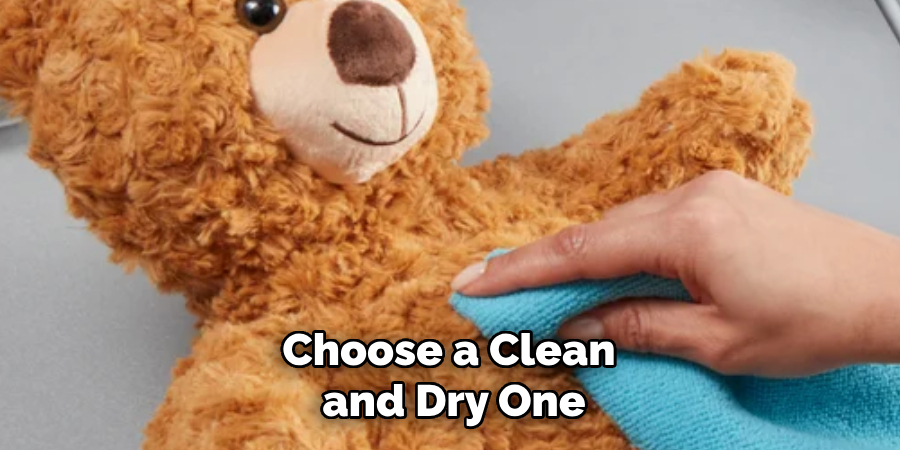
10 Easy Steps on How to Warm Up a Stuffed Animal
Step 1: Check the care instructions
Before warming up your stuffed animal, it’s important to check its care instructions. Some stuffed animals may not be suitable for heating or may have specific temperature restrictions. If you can’t find a tag with care instructions, it’s best to err on the side of caution and avoid heating the toy.
Step 2: Choose the Right Heat Source
Select an appropriate heat source after confirming that your stuffed animal is safe to heat. If you are using a microwave, ensure that the toy does not contain any metal parts and is microwave-safe.
For a heating pad or hot water bottle, check that the stuffed animal has no open seams that could allow heat to escape or cause burns. With alternative heat sources, such as warm towels or a hairdryer, ensure the heat is evenly distributed and not too intense to avoid damaging the plush toy.
Step 3: Prepare the Heat Source
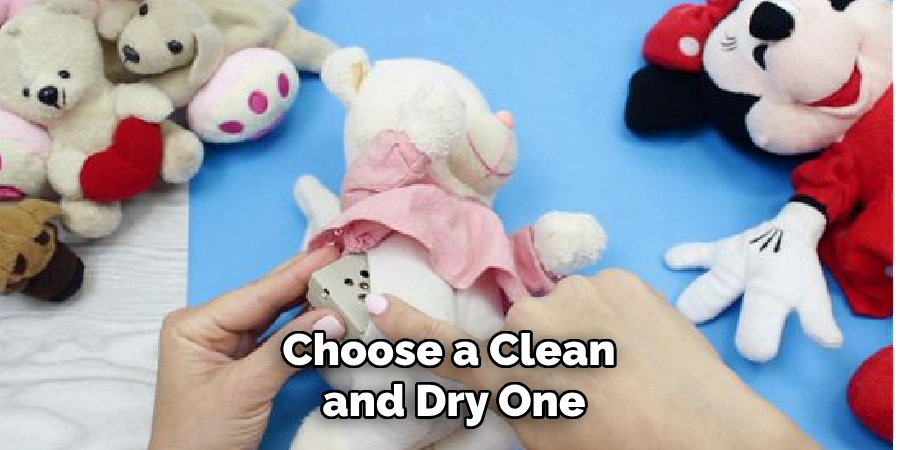
If you’re using a microwave, ensure that your container is clean and dry, then place the stuffed animal inside it. Warm them up to a comfortable temperature for a heating pad or hot water bottle before placing them against the stuffed animal. Remember not to overheat any element to prevent burning the toy or causing injury when handling it. If using a hairdryer, set it to a gentle, warm setting and keep it moving to avoid concentrating heat in one area.
Step 4: Heat the Stuffed Animal
Place your stuffed animal in contact with your chosen heat source. If using a microwave, heat the stuffed animal in short intervals of about 20 to 30 seconds to avoid overheating. When using a heating pad or hot water bottle, place the stuffed animal on top of the pad or bottle and allow it to warm for a few minutes gently. Monitor the temperature carefully to make sure it’s not getting too hot.
Step 5: Test the Temperature
After heating, carefully check the stuffed animal’s temperature before handling it further or giving it to a child. Gently press your hands against various parts of the toy to ensure it has warmed evenly and is not too hot. If the stuffed animal is too warm, let it sit for a few minutes until it reaches a comfortable temperature. Safety should always be your top priority to prevent burns or discomfort.
Step 6: Wrap the Stuffed Animal in a Blanket
Once the stuffed animal has reached a pleasant warmth, take a soft blanket and wrap the toy gently. This will help retain heat for extended periods, ensuring that the stuffed animal stays warm and cozy.
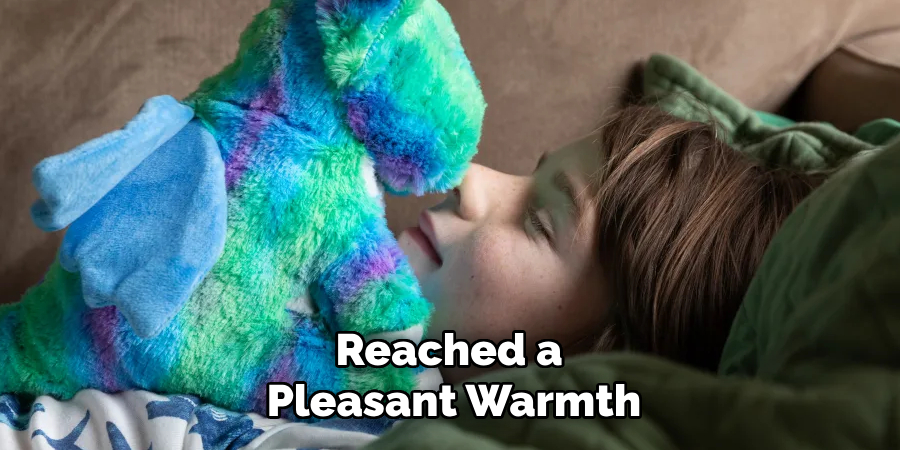
Be sure not to wrap the blanket too tightly to prevent heat from becoming trapped and potentially causing overheating. The blanket also adds an additional tactile element for an even more comforting experience.
Step 7: Cuddle or Place the Stuffed Animal Where Needed
Now that your stuffed animal is warm and wrapped, it’s time to cuddle or place it where warmth and comfort are desired. If it’s being used to soothe aches or pains, position the stuffed animal on the affected area, ensuring the temperature provides relief without causing discomfort.
For children or adults using the warm stuffed animal for comfort, it can now be held closely, providing a sense of security and coziness that can help with relaxation and stress relief.
Step 8: Monitor and Adjust Temperature as Needed
While enjoying the warmth of your stuffed animal, continuously monitor its temperature. If the warmth begins to fade, you can reheat the toy following the previous steps, making sure not to exceed the initial warming time. Always prioritize safety, especially when reheating, to maintain the stuffed animal’s integrity and avoid the risk of burns or discomfort.
Step 9: Allow the Stuffed Animal to Cool
Once the stuffed animal has served its purpose in providing warmth, it’s important to allow it to cool down before storing it away. Remove any blankets and place the toy in a safe area where it can return to room temperature. Ensuring the stuffed animal is completely cool helps to prevent any condensation or moisture buildup, which could lead to mold or mildew, especially in plush toys with electronic components.
Step 10: Store the Stuffed Animal Properly
After the stuffed animal has cooled down, store it in a clean, dry place. Avoid direct sunlight or damp areas to protect the fabric and internal materials. If you used a heating pad or hot water bottle, remember to empty or turn off these items to conserve energy and maintain safety. Proper storage will keep your stuffed animal in perfect condition, ready for the next time you need a warm and comforting cuddle.
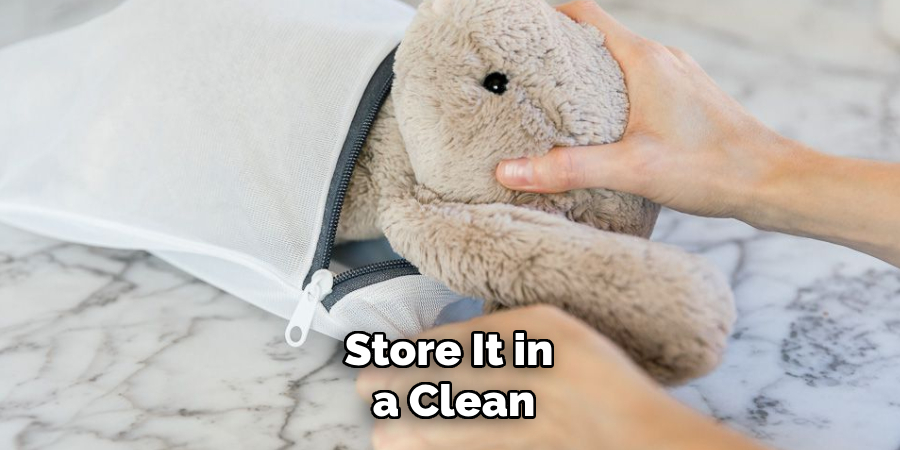
By following these easy steps, you can safely and effectively warm up your stuffed animal for a cozy and comforting experience. Whether it’s for relief from pain or discomfort or simply to provide a feeling of warmth and security, your stuffed animal can now be an all-around source of comfort during those chilly days and nights.
5 Additional Tips and Tricks
- Microwaveable Soft Pads: You can purchase or DIY microwaveable heating pads and tuck them inside your stuffed animal, if it has a suitable opening. Ensure the materials used for both the pad and the stuffed animal are microwave-safe.
- Wheat Bag Warmers: Wheat bags can be heated and placed with the stuffed animal to provide warmth. They are a safe alternative to electric heating, but be careful not to overheat them to prevent scorching.
- Warm Water Bottles: Slip a warm water bottle inside the stuffed animal’s embrace to make it toasty. Ensure the bottle is sealed properly to avoid leaks that could dampen and damage the toy.
- The Rice Sock Method: Fill a sock with rice, tie it off, and microwave it briefly. Once warm, place it in the stuffed animal’s lap or arms for a gentle, lasting warmth.
- Sun Bathing: Place the stuffed animal in a sunny spot in your home. This method will warm it up, but the sunlight can also help freshen the fabric and remove odors. Just remember to rotate it to prevent color fading.
With these additional tips and tricks, your stuffed animal will always be warm and cozy for cuddling. Remember to choose a safe method depending on the type of fabric and materials used in your toy.
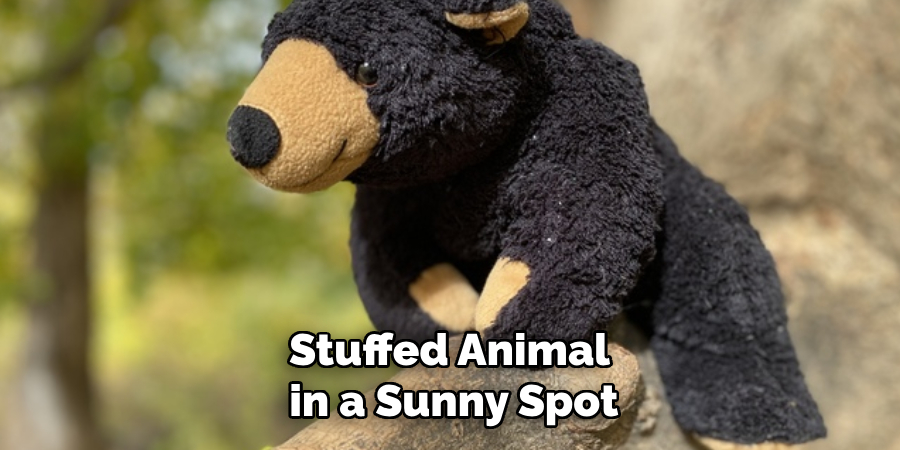
5 Things You Should Avoid
- Do Not Use Open Flames or High Heat: Avoid exposing your stuffed animal to open flames or placing it directly on a radiator or space heater. High heat can melt synthetic fibers and damage the toy.
- Steer Clear of the Oven or Microwave Unless Specifically Designed for It: Regular stuffed animals aren’t meant to go in the oven or microwave. Doing so could cause a fire or melt internal parts. Only use appliances with heat-safe materials if the toy is designed for it.
- Avoid Using Boiling Water or Steam: Soaking or steaming a stuffed animal can lead to mold growth inside the stuffing and deterioration of the fabric and color.
- Don’t Leave It on an Electric Blanket on High Heat: Just like with high heat sources, an electric blanket can be too hot for the material of your stuffed animal and potentially cause damage.
- Forgo Washing Machine’s Hot Cycle: While cleaning is not warming per se, some might be tempted to use a washing machine’s hot cycle to achieve both. This can be too harsh for the material and could ruin your stuffed animal. Stick with warm or cool cycles specifically recommended for soft toys.
By avoiding these actions, you can protect your beloved stuffed animals and keep them in top condition for years to come. Instead, try alternative methods such as using a hairdryer on low heat or wrapping the toy in a towel and placing it near a warm window. Always make sure to check the care instructions on the tag of your stuffed animal before attempting any warming methods.
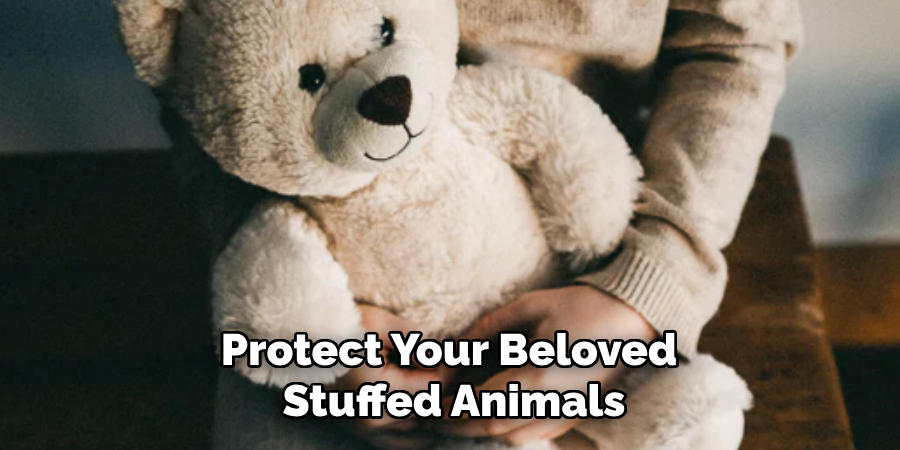
Some Frequently Asked Questions
1. Can You Microwave Stuffed Toys?
The answer is it depends. Some stuffed animals are designed specifically for microwave use and will have a tag or label stating so. These toys typically have special heat-safe materials and do not contain electronic components. However, most regular stuffed animals are not suitable for microwaving and can be damaged or pose safety risks if heated in this way.
It’s always best to err on the side of caution and follow the recommended warming methods we have outlined in this guide. If you are unsure or cannot find information on whether your stuffed animal is microwave-safe, it’s best to avoid microwaving it altogether. Instead, try using alternative warming methods that do not involve heat.
With these tips and guidelines, you can now safely and effectively warm up your favorite stuffed animals for a cozy and comforting experience.
2. Is It Okay to Wash Stuffed Toys?
Yes, it is generally okay to wash stuffed toys as long as the care instructions allow for it. It’s important to check the tag or label on your stuffed animal before washing, as some may have specific cleaning instructions. In general, most soft toys can be washed in a machine on a gentle cycle with mild detergent. Make sure to remove any batteries or electronic components before washing.
It’s also recommended to place the toy in a mesh laundry bag or pillowcase to protect it from damage. After washing, allow the stuffed animal to air-dry completely before using or storing it.
However, hand-washing may be a better option if your stuffed animal has significant stains or is made of delicate materials. Use a mild detergent and lukewarm water, gently scrub the stained areas before thoroughly rinsing. Again, make sure to air-dry completely before using or storing.
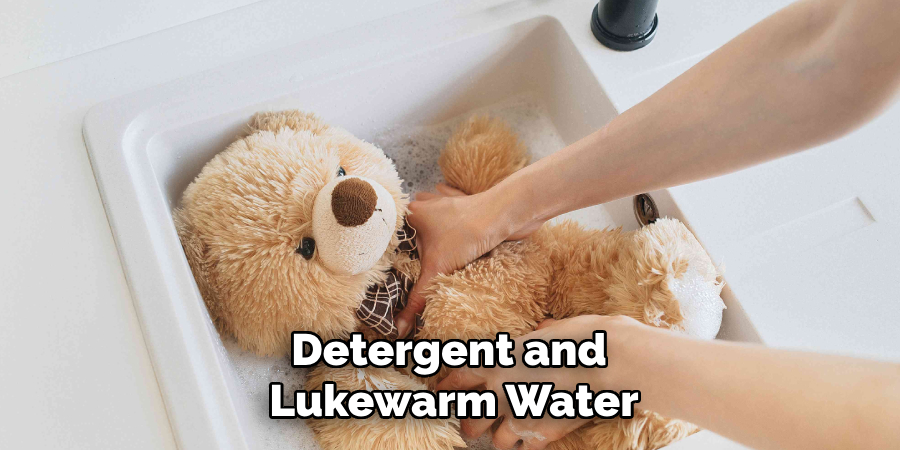
Overall, regularly washing your stuffed toys can help keep them clean and fresh for longer. Just be mindful of the materials used in your toy, and always check care instructions for specific guidelines on cleaning.
3. Why is My Stuffed Animal Lumpy?
If your stuffed animal has been washed or used frequently, it may start to feel lumpy or bumpy. This is normal wear and tear, as the stuffing inside can shift over time.
To fix a lumpy stuffed animal, you can try fluffing it up by gently kneading and massaging the toy. You can also add more stuffing if there are empty or flat spots. If the stuffing is clumped in certain areas, you may need to remove and redistribute it evenly throughout the toy.
However, if your stuffed animal has significant lumps or feels hard and uncomfortable, it may be a sign of water damage. In this case, it’s best to replace the toy with a new one for safety reasons.
Taking proper care of your stuffed toys, including washing and fluffing them regularly, can help prevent lumps and maintain their softness over time. So keep these tips in mind to ensure your cuddly companions stay warm and cozy for many years to come!
4. What’s the Difference Between a Plushie and a Stuffed Animal?
The terms plushie and stuffed animal are often used interchangeably, but there are some subtle differences between the two.
A stuffed animal is a toy made with fabric and filled with stuffing or other materials like beans or plastic pellets. They usually have realistic features of animals such as bears, dogs, cats, etc. Stuffed animals can also be referred to as plush toys.
Additionally, plushies are a type of stuffed animal that are often made to look like fictional characters or objects. They may also be smaller in size and typically have a softer, more huggable feel.
Both plushies and stuffed animals can provide comfort and companionship for people of all ages. Whether you prefer a realistic teddy bear or a cute cartoon character, there’s no denying the joy and warmth that these soft toys can bring.
Conclusion
In conclusion, how to warm up a stuffed animal can contribute to a more comforting and soothing experience, especially on chilly days. It’s essential to employ safe warming techniques that preserve the toy’s material integrity and ensure the health and well-being of its users.
Always avoid direct exposure to high heat sources, the use of boiling water, steam, or hot cycles in washing machines. If you have a stuffed animal designed for heating, like those with microwavable heat pads, follow the instructions carefully. Remember that the safety and care of the stuffed animal are paramount to keeping your fuzzy friends huggable and in pristine condition for years to come.
With proper care, your stuffed animals can continue to provide love and warmth in your life for a long time. So, next time you snuggle up with your favorite plushie or stuffed animal, remember these tips and enjoy the comfort they bring!
About the Author
Adrien Rowe, an expert in knitting, fiber arts, and bookbinding, promotes sustainability and creativity through workshops and tutorials. Passionate about education and community, he inspires crafters of all levels to learn, share, and grow in a supportive, idea-driven environment.
Professional Focus
Specializes in advanced knitting techniques, fiber manipulation, and textile innovation.
Expert in book arts, including cotton papermaking, handmade paper techniques, and bookbinding.
Dedicated to educating and inspiring crafters of all skill levels through tutorials, workshops, and hands-on learning experiences.
Passionate about creating a supportive community where makers can share ideas, learn, and grow.
Education History
Rhode Island School of Design (RISD) – Bachelor of Fine Arts (BFA) in Textiles.
University of Iowa Center for the Book – Master of Fine Arts (MFA) in Book Arts.
Expertise:
Advanced knitting, fiber manipulation, papermaking, bookbinding, sustainability-focused crafting, educational workshops, creative tutorials, and fostering a supportive maker community.
